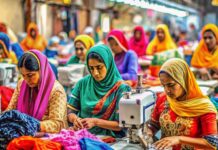In today’s rapidly evolving textile industry, supply chain disruptions and global trade dynamics are playing pivotal roles in driving innovation within textile machinery. As companies face challenges such as fluctuating trade policies, unpredictable logistics, and geopolitical uncertainties, they are compelled to seek advanced technologies to maintain competitiveness. Modern textile machinery is increasingly designed to be more efficient, sustainable, and adaptable, reflecting a strategic response to these external pressures. This innovation is crucial for businesses that aim to thrive amidst changing global market conditions.
The Impact of Supply Chain Disruptions on Textile Machinery Innovation
Challenges in Raw Material Sourcing
Supply chain disruptions have significantly altered the landscape of raw material sourcing for the textile industry. Traditionally, manufacturers relied on well-established supply routes for materials like cotton, wool, and synthetic fibers. However, recent global events, including pandemics and geopolitical tensions, have caused frequent interruptions. These disruptions compel textile machinery manufacturers to innovate and adapt by seeking alternative materials or local sourcing options.
The need for more resilient supply chains has also prompted companies to invest in technologies that optimize material usage and reduce waste. These innovations help safeguard production processes from future disturbances, creating a more sustainable and agile manufacturing environment.
Shifts in Production Processes
The instability in supply chains has necessitated shifts in textile production processes. Manufacturers now prioritize flexibility over rigidity, driving them to adopt technologies that can seamlessly handle varying material inputs and production volumes. This flexibility requires machinery that is adaptable and capable of operating under diverse conditions without compromising on quality or efficiency.
Advancements such as modular manufacturing systems and digital twin technology are being increasingly integrated into textile machinery. These technologies enable real-time monitoring and adjustments, allowing manufacturers to quickly respond to supply chain disruptions and maintain operational continuity.
Adaptation in Machinery Design
The disruptions have also catalyzed innovation in machinery design. To mitigate the impact of material shortages and transportation delays, companies are focusing on developing machinery that is not only efficient but also versatile enough to accommodate a broader range of materials and production methods. This adaptability reduces dependency on specific suppliers and allows manufacturers to pivot swiftly in response to changing conditions.
Innovations such as smart sensors and advanced automation have resulted in textile machinery that can self-optimize and enhance performance. These advancements contribute to increased productivity and ensure that the textile industry remains competitive despite ongoing supply chain challenges.
Influence of Global Trade Dynamics on Textile Industry
Trade Policies and Tariffs
Global trade dynamics, particularly policies and tariffs, play a crucial role in shaping the textile industry. Changes in trade agreements and the imposition of tariffs can significantly influence the cost and availability of textile goods. Manufacturers must constantly innovate to remain competitive, often opting for machinery that can deliver higher efficiency and lower production costs.
In response, there has been an impetus towards developing equipment that can handle complex manufacturing processes more economically, thereby enabling companies to absorb or offset the impact of tariffs on their products.
International Competition and Collaboration
The textile industry is highly competitive, with global players vying for market share. This environment encourages collaboration and technological exchange across borders. Innovations such as Industry 4.0, which emphasize interconnectedness and data exchange, thrive in this setting, fostering new machinery designs that capitalize on shared advancements.
Manufacturers also benefit from international collaborations that bring diverse perspectives and expertise, leading to more innovative solutions tailored to meet the demands of a global market.
Emerging Markets and Expansion Opportunities
Emerging markets present both challenges and opportunities for textile machinery innovation. As countries in Asia and Africa experience economic growth, their demand for textile products increases, driving the need for advanced machinery capable of meeting high production demands.
These regions serve as testing grounds for innovative textile solutions that balance quality and cost-effectiveness. Companies that successfully adapt machinery to cater to these emerging markets can secure significant expansion opportunities and establish themselves as leaders on the global stage.
Key Innovations in Textile Machinery
Automation and Smart Manufacturing
The textile industry is witnessing a transformative shift with the integration of automation and smart manufacturing technologies. These innovations aim to increase efficiency, reduce costs, and mitigate the challenges posed by unpredictable supply chains. Automated machinery is now capable of performing complex tasks at a faster pace, reducing the reliance on manual labor. Key features include:
– Robotic Automation: Machines equipped with robotic arms can handle delicate fabrics, ensuring precision and consistency.
– Smart Sensors: These smart devices monitor real-time data, allowing manufacturers to anticipate maintenance needs and prevent costly downtimes.
– Digitized Production Processes: Digital twins and virtual simulations streamline production, enabling quicker adjustments to meet dynamic market demands.
Sustainable and Eco-friendly Technologies
Sustainability has become a crucial focus in textile machinery innovation. Manufacturers are investing in eco-friendly technologies to minimize environmental impact and comply with global sustainability goals. New advancements in this area include:
– Waterless Dyeing Systems: These reduce water consumption drastically, addressing both cost and environmental concerns.
– Energy-efficient Motors: Modern machinery incorporates energy-saving technologies, cutting power usage while maintaining performance.
– Recyclable Materials: The industry is moving towards using recyclable components, promoting a circular economy within manufacturing processes.
Integration of AI and Data Analytics
Artificial intelligence and data analytics are revolutionizing textile machinery by providing insights that drive decision-making and boost productivity. These technologies enable factories to adapt swiftly to global trade fluctuations. Some prominent applications are:
– Predictive Maintenance: AI algorithms analyze data from machinery components to predict failures, ensuring timely interventions.
– Supply Chain Optimization: Data-driven insights help manage inventory and streamline logistics, reducing the impact of supply chain disruptions.
– Customization at Scale: AI allows for personalized designs and specifications, catering to niche market demands while maintaining mass-production efficiency.
These key innovations are not only shaping the future of textile machinery but are also helping the industry navigate the complexities of global trade dynamics and supply chain disruptions.
Conclusion
In today’s interconnected world, supply chain disruptions and shifting global trade dynamics are catalysts for innovation within the textile machinery sector. As manufacturers adapt to these challenges, they are compelled to innovate swiftly and efficiently. Modern advancements are primarily focused on boosting productivity, enhancing sustainability, and encouraging flexibility in production processes.
– Technological advancements in textile machinery are driving change, supporting manufacturers in mitigating supply chain vulnerabilities.
– Innovators are prioritizing automation and smart technologies to forecast potential disruptions and maintain consistent output.
By embracing these new advancements, the textile industry is not only navigating current challenges but also positioning itself to thrive in a rapidly changing global landscape. This alignment of innovation and adaptability stands as a testament to the industry’s resilience and is a leading example for other sectors facing similar challenges.






























